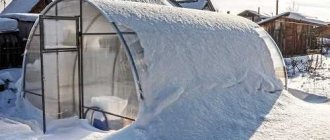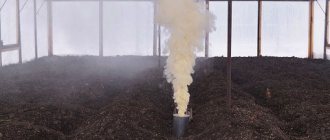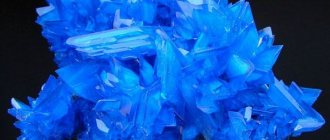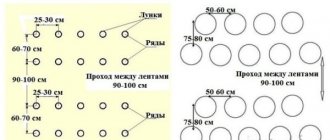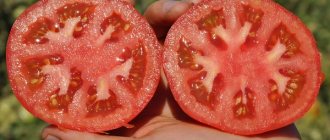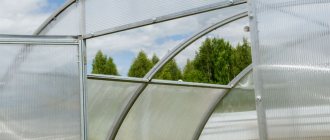Greenhouses and hotbeds are quite common in suburban areas. Less common are greenhouses and winter gardens - the latter are generally considered to be objects of extraordinary luxury. Even less common in mid-latitudes are buildings with a partially glazed roof.
Mounting diagram
For the most part, the low prevalence of such structures is associated with the material used - silicate glass. It is quite heavy, fragile - unless special classes are meant, and special equipment must be used to give it curved shapes. As a result, the cost of the material turns out to be quite hefty. Using polycarbonate allows you to easily solve the problem.
How to connect polycarbonate sheets together
Greenhouses and hotbeds are quite common in suburban areas. Less common are greenhouses and winter gardens - the latter are generally considered to be objects of extraordinary luxury. Even less common in mid-latitudes are buildings with a partially glazed roof.
For the most part, the low prevalence of such structures is associated with the material used - silicate glass. It is quite heavy, fragile - unless special classes are meant, and special equipment must be used to give it curved shapes. As a result, the cost of the material turns out to be quite hefty. Using polycarbonate allows you to easily solve the problem.
Material characteristics
Polycarbonate is a polymer based on ester compounds of carbonic acid. Using various methods, raw materials can be used to make building panels, various containers, medical equipment, ceilings and lenses for microscopes. The material is used very widely.
For the consumer, the following properties are of greatest importance:
- strength – much superior to both silicate and acrylic glass;
- light transmittance – quite comparable to that of glass – 75–86%;
Fastening accessories
- fire safety - unlike its acrylic “brother”, polycarbonate is a non-flammable substance;
- thermal insulation is much superior to glass, especially when it comes to cellular panels. In greenhouses and greenhouses, the use of polycarbonate can reduce heating costs by up to 30%;
- lightness - low density ensures low weight of the product with high strength. Installation of structures, as well as joining of slabs, is a job that can be done independently;
- flexibility - it is quite easy to give the panels a curved shape directly at the installation site.
Polycarbonate panels
For construction work, two types of products are produced: monolithic panel and honeycomb.
- Monolithic is a solid slab without voids. Its strength is sufficient to be used for the construction of self-supporting structures. Polycarbonate glazing is carried out at the largest industrial and public facilities, for example, at indoor stadiums. At the same time, the weight of the panel is small, which allows it to be successfully used in private construction.
- Cellular - gets its name due to its structure - cavities formed when two or more sheets are connected with stiffening ribs. For greenhouses and greenhouses, as a rule, it is the cellular sheet that is used, since it has higher thermal insulation properties: the air in the cavities is a good thermal insulator and enhances this quality in the finished product.
Honeycomb slabs are very diverse. Not only the thickness of the product differs, but also the structure: the panel can consist of two, four, five layers. Honeycombs can have different shapes - hexagonal, trapezoidal, rectangular. The material is selected depending on the purpose. So, for example, for winter greenhouses it is preferable to choose products with a thickness of more than 8 mm, and for the design of small advertising boards, 4 mm is sufficient. The photo shows a polycarbonate greenhouse.
End profile
The end profile is used to cover the empty ends of the polycarbonate sheet. The correctness of its fastening lies in the fact that the connecting profile joins adjacent panels and provides a reliable and durable connection, as shown in the photo.
There is also a ridge profile, but it is not used for greenhouse roofs with a curved top.
Aluminum fasteners
Mostly people make fasteners from aluminum profiles, since they have the great advantage of the reliability of the material itself and absolute water and moisture impermeability. It is easier to lay plastic on such profiles due to the fact that special rubber seals are used here, as shown in the photo. This type of profile is produced under polycarbonate, which has different widths, from 6 to 25 mm and a mandatory length of 6 m.
It makes no difference what angle the sheet or panel will form. You can even mount it vertically, but you need to make sure that the voids or ducts that are inside are in the same position. When producing such a curved roof or canopy, these cavities must be located under the curve. All ducts are directed towards the slopes.
Methods for connecting sheets together
Installation of slabs is carried out using a variety of methods depending on the frame material and the purpose of the premises. If there is a need to connect the panels to each other, and not just attach them to the beams, then fastening with a detachable and one-piece profile is used.
Detachable - aluminum or plastic, consists of two parts. Installation is done in this way.
- The lower part of the profile is fixed to the frame beams. If the frame is metal, you should use thermal washers; if it is wooden, you can use ordinary self-tapping screws. The step is 30–50 cm.
- The panels are positioned so that their edges are within the boundaries of the base. In this case, a gap of 3–5 mm should be maintained between the edge of the slab and the base of the profile. As a rule, the aluminum profile is equipped with rubber gaskets, which makes it easier to fasten.
- The upper part is placed on the base and snapped along the length.
One-piece profile - forms a single structure. Connecting the sheets together using a one-piece profile is even easier. However, in this case there are no rubber gaskets, so the degree of fastening can only be adjusted manually.
- The material is cut according to the required dimensions - the joining point should be located on the frame beam.
- The one-piece profile is fixed to the sheathing with self-tapping screws with a thermal washer, regardless of the frame material.
- Polycarbonate is inserted into the profile. If necessary, the grooves can be additionally lubricated with sealant.
Glue mounting
When constructing small objects - gazebos, verandas, glue fastening is often used. A one- or two-component polymer composition is used for this.
For gluing, simply apply glue along the edge of the sheet and connect them together. It is recommended to use a special gun when working, since the polymer glue hardens very quickly. It is permissible to use methyl or ethyl chloride solvents as an adhesive.
Selection of sheet joining technology
The method of connecting panels made of cellular or monolithic polycarbonate is selected based on the design characteristics and one’s own preferences. Sheet material can be joined using
:
- one-piece profile;
- split profile;
- silicone glue or solvent based on methylene chloride or ethyl chloride.
Both types of connecting elements are made of polymer or aluminum. Depending on the technology by which it is planned to connect the panels, standard self-tapping screws with a flat head or self-tapping screws with thermal washers made of polymer material are used. The latter allow you to reliably seal the attachment points.
Be sure to read: How to properly attach polycarbonate to metal: how to fasten it and which side
Main types of fasteners for sheets
To properly install the fasteners, an electric drill and a screwdriver are required. To attach polycarbonate sheets to the frame, it is recommended to choose self-tapping screws with legs whose thickness corresponds to the thickness of the panel. This will prevent the fasteners from being over-tightened during installation. It should also be taken into account that the hole in the polycarbonate for fasteners is prepared with a drill whose diameter is 2 mm larger than the diameter of the leg
. This gap is necessary for thermal expansion of the material.
Rules for drilling cellular polycarbonate
Let's take a closer look at how to join polycarbonate to create a reliable gazebo roof or canopy over the entrance to a house, a carport, a greenhouse or a greenhouse.
One-piece profile
The one-piece linear profile has grooves on the sides into which polycarbonate sheets are inserted, as well as a central channel formed by two jumpers. This channel is used to attach the connecting element to the structure frame. The aluminum profile is fixed with ordinary metal screws; for a polymer profile, it is recommended to use self-tapping screws with a thermal washer. Fastening elements are installed at an angle of 90 degrees to the surface of the profile. In this case, the self-tapping screw must pass through its central channel and enter the sheathing by at least 5 mm
.
Before attaching the outermost joining profile to the frame, you should insert the edge of the panel into it and put the same profile on the second edge. Help will be needed to level the structure, since the connecting profiles must fall exactly on the center of the frame elements on which they are fixed. If the sheets are joined without support, the flooring will not withstand external loads.
Installation via one-piece profile
The edge of the next polycarbonate sheet is inserted into the free groove of the second profile, and the operation is repeated until all the material has been laid. Before attaching polycarbonate flooring, make sure that there is a gap of 2–3 mm between the edge of the sheet and the internal jumper of the connecting element; this is necessary for thermal expansion
.
Be sure to read: Characteristics of polycarbonate: width and thickness of sheets
The connecting one-piece profile is usually made of polymer material. Its protruding edges are curved due to which it firmly holds the sheet material. Aluminum products are also used. Their internal configuration and damping pads help to secure the sheet.
Split profile
For joining polycarbonate sheets, it is most convenient to use a split profile, especially if you need to join the covering elements of an arched structure. The instructions provide the following stages of work
:
- the lower part of the profile is attached to the frame using screws for metal or wood (the choice depends on the material of the frame and the profile, the attachment points are located in the central channel in increments of 30–50 cm);
- the panels are laid in such a way that their edges fall on the sides of the lower part of the profile and there is a gap of 2–3 mm to the vertical wall of the element;
- After the edges of the panels on both sides are laid in the profile, the top strip of the profile is laid, leveled and latched with light blows of the palm or a wooden hammer.
Connection via split profile
Adhesive technology
The use of profiles does not allow obtaining a perfectly flat and smooth surface, since the joining elements extend beyond the plane of the panels. To create an aesthetically attractive structure with the effect of a solid translucent canvas, the polycarbonate gluing method is used.
This technology requires the use of a special silicone-based adhesive. The composition is applied to the side surface of the sheet along the entire length using a mounting gun for dosed supply of glue. It is necessary to evenly distribute the adhesive mass over the joining surface and press the edge of the second sheet against it. The glue dries very quickly, which should be taken into account when working
.
Example of glue for joining
Instead of silicone glue, you can use ethyl chloride or methylene chloride solvents. Both abutting edges are treated with the composition and the polycarbonate sheets are connected to each other. After the dissolved polymer material dries, the seam becomes durable, airtight and invisible.
Be sure to read: How and how to cut cellular and monolithic polycarbonate at home
The joining of polycarbonate must be tight to ensure the strength of the seam. A correctly executed joint is airtight; such structures do not allow precipitation to pass through.
Advantages of polycarbonate
Firstly, polycarbonate is transparent, so it can replace glass. It is much lighter than glass, and its strength is 50 times higher, which is why its installation will stop much easier.
Polycarbonate is practically not afraid of all kinds of chemicals, which increases its durability and maintains a presentable appearance for a long time. One of the important properties of cellular polycarbonate is that it can be used as an excellent protective agent against ultraviolet radiation. The resistance of this material to high temperatures is so great that it can be used in regions with any climate. And thanks to the special structure and shape of the sheets, polycarbonate becomes an excellent heat and sound insulating, as well as moisture-proof material.
What tools and materials are needed?
As already mentioned, a circular saw, hacksaw or metal saw is suitable for cutting sheets into pieces of the required size. Further joining of polycarbonate can be done with factory-made profile fasteners. The number of such fasteners will depend on the surface area of the polycarbonate being laid. Do not forget about skates, corners, bends and other structural elements.
No special professional tools are required to work with polycarbonate. It is enough to use a regular drill, hammer, screwdriver or screwdriver. Please note that in order to avoid damage to the material when connecting polycarbonate sheets to each other, it is advisable to perform the work on a large flat surface. The use of split-type profiles involves the use of a flat wooden plank.
How to connect sheets together using profile joining
As a rule, sheets of this material are produced with dimensions of 2100 × 12000 mm, and their thickness ranges from 4 to 32 mm. Polycarbonate sheets are quite easy to cut; all you need is a hacksaw or a circular saw.
The joining of polycarbonate sheets has its own nuances, and is carried out either using a profile connection or using special adhesives.
Linear profiles of detachable and one-piece type
The joining of polycarbonate sheets is carried out using linear profiles, which are divided into detachable and one-piece. When working with a one-piece type profile, polycarbonate is inserted into the grooves, after which the fastening system and panels are through-fastened with self-tapping screws. It is advisable to use self-tapping screws equipped with special gaskets or thermal and moisture-proof washers.
The process of connecting polycarbonate sheets together using split-type profiles is more complex. Before joining the polycarbonate on the canopy, the base of the profile joint is secured to flat wooden planks using screws. After this, the prepared polycarbonate panels are placed in special recesses, and then both halves of the profile are fastened together. A polycarbonate lock is used for these purposes. After all the manipulations, the bases of the profile fastening can be unscrewed from the strip, since the connection is complete. To give a polycarbonate canopy a finished look, a special external profile is used. It allows you to decorate the edges of the material, as well as combine the panels into one continuous surface.
Types of profiles
There are several types of joining profiles for polycarbonate, each of them has its own designation, consisting of two letters of the English alphabet. These are UP, HP, RP, SP and FP, where P is the first letter of the word Profile. Each profile has its own purpose of use and purpose. For example, a detachable connection is designated as SP, and a one-piece connection is designated as HP.
Options for joining polycarbonate profiles
Table. Description and characteristics of detachable and one-piece profiles.
| Profile type | Description |
| One-piece | It is made only of plastic and, as a rule, costs less than a detachable one. Typically used for conventional joining of two sheets of material in straight and curved structures. Working with it is somewhat more difficult than with a split profile - the fact is that here you need to manage to correctly fit both polycarbonate sheets being connected into this profile. Typically, a one-piece H-profile is used to connect thin parts. It also does not provide complete sealing of the joints. The main advantage of this type of connecting profile is its small thickness, due to which “bumps” do not appear on the surface of the material. This element may even be completely invisible on a greenhouse or any other structure if it matches the color and thickness of the polycarbonate used. |
| Sectional | Can be made of either aluminum or plastic. A profile that has a base and a special cover, connected to each other using a special “lock”. It is more convenient to use than the one-piece type and offers greater functionality. First, the base is attached to the base, and then the top cover. The profile from the cross-sectional side is an inverted letter H. Between two plastic strips connected in the middle, two cavities are formed in which sheets of material are attached. The profile has a special chamber where holes are drilled for fastening elements - self-tapping screws, bolts. The plastic joining profile itself is not a part of the frame and cannot be used as a load-bearing element. But aluminum may well give the frame strength and can even partially serve as a frame. |
The split profile is used to connect polycarbonate sheets with a thickness of 6 to 8 mm, as well as 16 and 25 mm. At the same time, to connect material 16 mm thick, experts recommend using only a split profile. Also, during installation, it is important to pay attention to the process of snapping the cover onto the base - the fact is that if you apply excessive force, the fasteners can easily be broken, and the cover will not snap into place at all. It's important to be careful (so don't use hammers!).
Scheme of fastening a detachable docking profile
The letters RP indicate a ridge profile. It connects and at the same time protects two sheets of cellular polycarbonate in the “ridge” area on gable or pointed greenhouses or roofs. Typically used on roofing structures at an angle of 90 to 150 degrees. At the same time, it provides the necessary tightness and joint density at any of these angles. The ridge profile can be made of either plastic or aluminum; it can be either detachable or one-piece. Its structure strongly resembles an H-profile.
Ridge profile for polycarbonate
Aluminum ridge profile mounting diagram
The wall profile is designated as UP and is used in cases where a polycarbonate structure is connected directly to the wall, for example, of a residential building. Also used for attaching polycarbonate to beams, corners, and panels. In cross-section, this element resembles the letter F.
Wall profile for polycarbonate
Wall profile
The abbreviation FP usually denotes a corner profile, which is used to connect two sheets of polycarbonate at an angle of 90 degrees. And if the wall profile has only one groove for material, then the corner profile has two, in each of which you can put a sheet. This profile is no longer as flexible as a conventional connecting profile, but it provides a reliable connection between two planes.
Corner profile for polycarbonate
There is also an end profile - it is not a connecting one, but is necessary so that the entire assembled polycarbonate structure takes on a harmonious and complete look. It is U-shaped and is used to protect the end part of the material, preventing debris and dirt from entering the honeycomb. Snaps onto the end of the polycarbonate without the use of glue or fasteners.
End profiles for polycarbonate
Correct installation of the end profile
Table. Types and sizes of joining profiles .
| Profile type | Length, m | Width, mm | Thickness, mm |
| Docking | 6 | — | 6, 8, 10 (4 only for the one-piece type, 16 – only for the split type) |
| Wall-mounted | 6 | 4-32 | 8, 10, 16 |
| Skate | 6 | 60, 80 | 4-6 and 8-10 |
| Tortsevoy | 2,1 | — | 4, 6, 8, 10 and 16 |
Note: the thickness of the end profile is matched to the specific thickness of the polycarbonate.
Special and angular profile fasteners for joining
Since it is sometimes necessary to connect polycarbonate together on surfaces with complex terrain, profile corner fastenings are produced in the industry. Their installation method is practically no different from the linear type of products. As a rule, corner profiles of one-piece type are used in the work. They allow you to decorate areas of the structure in which the joining of polycarbonate panels should be carried out at an angle.
Often home craftsmen wonder how to properly join polycarbonate in places such as the ridge girder, which serves to connect two or more slopes on the roof of a building. To equip such areas, a special corner profile is used, which is also called a “ridge”. This type of fastening is used primarily for equipping open or enclosed terraces in private or country houses, as well as for equipping greenhouses or greenhouses.
Please note that polycarbonate panels undergo thermal expansion when exposed to temperature. Therefore, before joining the polycarbonate sheets, they need to be laid with a small gap between the profile and the panel, approximately 2-5 mm, to avoid deformation of the material.
How to connect polycarbonate in a greenhouse
On greenhouses with arched or straight slopes, buyers prefer to install polycarbonate with an overlap. Greenhouses usually come in multiples of 2 m in length. The polycarbonate sheet is 2.1 meters wide. Therefore, a greenhouse, for example, 4 meters high, is covered with two sheets of polycarbonate, where out of the extra 20 cm of plastic, 10 cm goes for overlap, and 5 cm goes for release on each side at the ends of the greenhouse. This 5cm outlet ensures that rain and debris do not enter the polycarbonate honeycombs mounted on the end of the structure.
up
How to join polycarbonate on a canopy using the gluing method
The undoubted advantage of profile fasteners for polycarbonate is their reliability, durability, and ease of installation. However, such connections on the roof surface are simply impossible to miss. In some situations, it is necessary to join the material in such a way that there are no visible connections. For such purposes, a special composition is used that allows polycarbonate panels to be glued together. As a rule, such glue can be bought in the same place as the base material. In order to obtain a particularly strong connection, polycarbonate can be glued with a silicone-based composition.
Please note that you can obtain a reliable connection of polycarbonate sheets by gluing using solvents based on methylene chloride, ethyl chloride or mixtures thereof. The use of such compositions for gluing polycarbonate allows you to give the structure a beautiful appearance. In addition, no moisture from the outside will simply be able to seep into such seams, since the connection is very tight.
In conclusion, it is worth noting that the positive characteristics of polycarbonate, including resistance to mechanical and chemical stress, low weight and ease of installation, strength, as well as protection from ultraviolet radiation, make it very popular in the building materials market. A high-quality and reliable connection of the panels will allow you to use polycarbonate for a long time.
How polycarbonate is joined
Connecting polycarbonate to each other in a greenhouse is a fairly simple process; the main thing is to take into account the basic recommendations regarding their joining. There is one point here: the greater the thickness of the polymer material, the more expensive the connection system.
How to join cellular polycarbonate
To join polycarbonate on a greenhouse with a thickness of 16 mm with a lathing of 1x2 m, you need to use an aluminum connecting profile. The plastic option is ineffective under conditions of excessive load during thermal expansion. Due to the impact on the fasteners, cracking appears in the sheets, caps from thermal washers also often begin to come off, and polymer plates are subject to severe deformation. So, if the thickness of universal polymer plastic is in the range of 4-10 mm, then the connection of cellular polycarbonate should be made using plastic profiles, and in other cases - aluminum.
How to join monolithic polycarbonate
When arranging a structure with cast slabs up to 3 mm thick, you need to use a silicone-based adhesive. Plastic profiles are used for joining sheets with a thickness of 4-6 mm, and those made of aluminum or steel are used for panels with a thickness of 7 mm or more. If there is a need for the absence of visible connections, then it is effective to use special compounds - adhesives, which are sold in the same store as synthetic polymer plastic.
Important! For reliable joining of polycarbonate, solvents based on methylene chloride, ethyl chloride, or a combination thereof are suitable. This method of gluing transparent boards makes it possible not only to achieve a beautiful appearance of the designed structure, but also to prevent moisture from entering the seams from the outside.
How professionals work
Proper sealing of joints for a polycarbonate greenhouse is a guarantee of durability with reasonable use. Professionals successfully use thermal bonding for such work - it is reliable, practical, and aesthetically pleasing.
Two sheets of polycarbonate are heated simultaneously, as indicated in the instructions for the device, and then they are automatically connected by soldering. When working, it is important not to deviate from the recommended temperature regime.
With this type of fastening, gaps should be provided to ensure the drainage of water - rain, melted snow.
For home work, this method is not optimal, as it requires certain skills and special equipment. Of course, this is not a reason for despondency - there are always alternatives.
Connecting individual polycarbonate sheets using a profile, glue or point fastening is simple and accessible to everyone.
How to join polycarbonate?
How to properly use polycarbonate connecting profiles? Let's consider the installation and joining of two sheets using a split type of profile.
How to connect polycarbonate sheets using a profile
Step 1. We place one of the halves of this element - the base - on a frame base (for example, on the edge of a greenhouse frame). Then we make holes in the center for the screws.
Drilling a hole in the base
Step 2. After this, using self-tapping screws, tightly fix the base to the frame.
Fixing the base on the frame
Step 3. We place polycarbonate sheets on both sides into the side grooves of the base.
Polycarbonate sheets are placed in the grooves
On a note! The sheets should protrude slightly above the end of the frame and profile.
Step 4. After the sheets have been installed, we lay the second half of the profile on top of them - the cover.
Installing the cover
Step 5. We fix the locks using short presses of moderate force in the center of the profile along the entire length.
Fixing locks
Instructions for the use of polycarbonate profiles when installing sheets of cellular polycarbonate. Downloadable file (click the link to open the PDF in a new window).
Instructions for use
Installation diagram of a detachable docking profile
Video - Connecting two sheets of polycarbonate using a split profile
When laying the sheets on the base, it is important to ensure that they are positioned evenly and that there are no unnecessary cracks or distortions. Only after this do we close the lid. The end profile and other types of this element are simply put on the ends of the sheets. The exception is the permanent connector. It is not so easy to install, especially in arched structures - it fits into the grooves quite tightly. But you can simplify your task by lubricating the inside of one of its sides with oil, and sealing the pushed sheet along the edge with tape.
Self-tapping screws for polycarbonate
Due to the technological features of the polymer material, nails, metal clamps or rivets cannot be used for fastening it. The best option seems to be to use self-tapping screws. Read more here.
Video - Connecting two sheets of polycarbonate using a one-piece profile
Preparatory part of the work
Regardless of the chosen method of joining polycarbonate, the sheets need to be prepared for work:
- Sheets of working material are removed from the common stack, avoiding damage;
- Using pre-prepared tape, the ends are isolated, defining the top and bottom of the sheet; •
- You should pay attention to the location of the stiffening ribs - this will be needed later to fix the material during operation.
- An incorrect attempt to bend the sheet will damage the polycarbonate.
- Determine the type of connection - gluing or using a profile, thermal washers, prepare the necessary tools, auxiliaries and organize the workplace - you may need an open space, for example, a carpenter's table.
Using a profile for fastening
If the polycarbonate will be fastened using a profile, you need to have the necessary tools on hand: a saw, standard fasteners, a drill, a hammer, a screwdriver and other carpentry tools if necessary.
There are no special requirements for the cutting tool - it can be a hand saw, a circular saw, or for cutting metal.
There is no point in saving on the number of fasteners - due to bends, corners, and roof slopes, the preliminary calculation may turn out to be less than what is ultimately needed to securely fix the polycarbonate.
Docking profiles are also made from polymer plastic. The one-piece structure is fixed using self-tapping screws.
If the choice falls on the detachable option, then you should follow the manufacturers’ recommendations - the accompanying documents for the product indicate how to correctly position the profile and sheets so that the mounting cover snaps into place.
How to connect polycarbonate on a canopy or fence
Canopies, fences, partitions and other structures are usually mounted using connecting profiles. To connect sheets together, there are so-called split HCP profiles and one-piece HP profiles. One-piece ones are cheaper, but when connecting long sheets, installation is labor-intensive. Detachable profiles are more expensive and consist of two parts - a base and a cover. First, the base is screwed onto the structure, then 2 polycarbonate sheets are laid and screwed to the structure, and finally the HCP profile cover is installed and the cover is secured with latches.
IMPORTANT! When connecting polycarbonate with profiles, it is necessary to lay it with a gap of at least 2 mm - the polycarbonate must be allowed to “breathe”. Plastic expands in the sun. If there is no gap, a “wave” and squeaks may form.
up
Using glue
When purchasing polycarbonate sheets for household needs, it is wise to simultaneously buy special glue, and if possible, also acquire a gun for uniform application of the adhesive. It is also permissible to manually distribute a thin layer of quick-drying substance.
You should work slowly, but also not allow the glue to harden prematurely - redoing poor-quality work is always unpleasant.
The result of careful work will be a visually difficult to distinguish joint of polycarbonate sheets - in the photo you can see the junction.
The adhesive should not contain a solvent - it will lead to premature wear of the material.
If necessary, you can use silicone designed for gluing plastic - it is much stronger than conventional one- and two-component types of glue.
